Soviet War Memorial (Treptower Park)
The Soviet War Memorial is a war memorial and military cemetery in Berlin's Treptower Park. It was built to the design of the Soviet architect Yakov Belopolsky to commemorate 7,000 of the 80,000 Red Army soldiers who fell in the Battle of Berlin in April–May 1945. It opened four years after the end of World War II in Europe, on May 8, 1949. The Memorial served as the central war memorial of East Germany.
| Soviet War Memorial | |
|---|---|
| Treptower Park | |
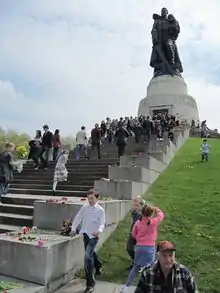 Visitors at the 65th Victory Day celebration laying flowers | |
| For Soviet war dead of the Battle of Berlin | |
| Established | May 8, 1949 |
| Location | 52°29′15″N 13°28′06″E near |
| Designed by | Yakov Belopolsky |
The monument is one of three Soviet memorials built in Berlin after the end of the war. The other two memorials are the Tiergarten memorial, built in 1945 in the Tiergarten district of what later became West Berlin, and the Schönholzer Heide Memorial in Berlin's Pankow district.
Together with the Rear-front Memorial in Magnitogorsk and The Motherland Calls in Volgograd, the monument is a part of a triptych.
History
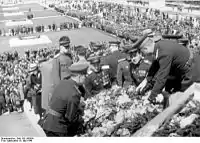
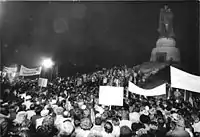
At the conclusion of World War II, three Soviet war memorials were built in the city of Berlin to commemorate Soviet deaths in World War II, especially the 80,000 that died during the Battle of Berlin. The memorials are not only commemorative, but also serve as cemeteries for those killed.
A competition was announced shortly after the end of the war for the design of the park. The competition attracted 33 entries, with the eventual design a hybrid of the submissions of the architect Jakow S. Belopolski, sculptor Yevgeny Vuchetich, painter Alexander A. Gorpenko and engineer Sarra S. Walerius. The sculptures, reliefs, and 2.5 meter diameter flame bowls were cast at the Lauchhammer Kunstgießerei (Art Foundry) in 1948.[1] The memorial itself was built in Treptower Park on land previously occupied by a sports field. The memorial was completed in 1949. It was rumoured that the remains of the Reich Chancellery had been used for the construction of the memorial, but this was not the case.[2]
Around the time of the fall of the Berlin Wall, unknown persons vandalized parts of the memorial with anti-Soviet graffiti. The Spartacist party (de) claimed that the vandals were right-wing extremists and arranged a demonstration on January 3, 1990, which the PDS supported; 250,000 GDR citizens participated. Through the demonstrations, the newly formed party stayed true to the communist roots of its founding party, and attempted to gain political influence.[3] The International Communist League spoke to the crowd. Them noting that "for the first time in 60 years, Trotskyists addressed a mass audience in a workers state. Participants and those listening on radio and TV heard two counterposed programs: that of the Stalinist SED, and that of the Trotskyist ICL".[4] PDS chairman Gregor Gysi took this opportunity to call for a Verfassungsschutz ("Constitution Protection") for the GDR, and questioned whether the Amt für Nationale Sicherheit (Department of National Security, the successor of the Stasi) should be reorganized or phased out. Historian Stefan Wolle believes that Stasi officers may have been behind the vandalism, since they feared for their jobs.[5]
As part of the Two Plus Four Agreement, Germany agreed to assume maintenance and repair responsibility for all war memorials in the country, including the Soviet memorial in Treptower Park. However, Germany must consult Russia before making any changes to the memorial.
Since 1995, an annual vigil has taken place at the memorial on May 9, organized by (among others) the Bund der Antifaschisten Treptow e.V. ("Anti-fascist Coalition of Treptow"). The motto of the event is the "Day of Freedom", corresponding to Victory Day, a Russian holiday and the final surrender of German soldiers at the end of World War II.
Layout
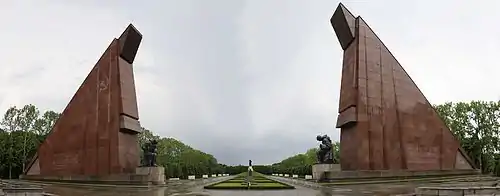
The focus of the ensemble is a monument by Soviet sculptor Yevgeny Vuchetich: a 12-m tall statue of a Soviet soldier with a sword holding a German child, standing over a broken swastika. According to Marshal of the Soviet Union Vasily Chuikov, the Vuchetich statue commemorates the deeds of Sergeant of Guards Nikolai Masalov (1921-2001), who during the final storm on the center of Berlin risked his life under heavy German machine-gun fire to rescue a three-year-old German girl whose mother had apparently disappeared.[6]
Before the monument is a central area lined on both sides by 16 stone sarcophagi, one for each of the then 16 Soviet Republics[Note 1] with relief carvings of military scenes and quotations from Joseph Stalin, on one side in Russian, on the other side the same text in German: "Now all recognize that the Soviet people with their selfless fight saved the civilization of Europe from fascist thugs. This was a great achievement of the Soviet people to the history of mankind". The area is the final resting place for some 5000 soldiers of the Red Army.
At the opposite end of the central area from the statue is a portal consisting of a pair of stylized Soviet flags built of red granite. These are flanked by two statues of kneeling soldiers. Beyond the flag monuments is a further sculpture, along the axis formed by the soldier monument, the main area, and the flags, is another figure, of the Motherland weeping at the loss of her sons.
In recent years, the ensemble has undergone a thorough renovation. In 2003 the main statue was removed and sent to a workshop on the island of Rügen for refurbishment. It was replaced on May 4, 2004.
In literature
The Soviet War Memorial is described in detail in M.M. Kaye's novel Death in Berlin, written in 1953 and based on Kaye's first-hand impression of the then freshly inaugurated monument. The protagonists - British officers stationed in Berlin and their wives and families - are far from well disposed towards the Soviets, but are still greatly impressed with what they see: "Two giant statues of kneeling Russian soldiers, their heads bared in homage - statues, steps and the towering expanse of red marble dwarfing the steam of sightseers".
One of Kaye's British characters makes the prediction - since then disproven by events - that the Soviet monument would be demolished "five minutes after the Soviets move out of East Germany, whenever that is". He then adds that such a demolition would be a great pity, since the monument was "the equal of Karnak, Luxor and the Acropolis".
Commemorations
Rallies and ceremonies are held on the memorial by local Berliners.[7] A chairwoman of the antifascist union of Treptow district said that, "We will never forget the feat of Soviet warriors who liberated not only their Motherland but the German nation too, as well as many European countries from the 'brown plague'."[8] In 2019, Russia's ambassador to Germany, a deputy of the Moscow City Duma, the Chairman of the Chamber of Deputies of Berlin and the head of the German People’s Union for the Care of War Graves all took part in the a ceremony marking the occasion of the centenary of the German War Graves Commission. Participants laid flowers at the monument to honour the memory of Soviet soldiers.[9]
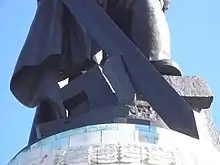
Notes
- Between 1940–56 (up to the reorganization of the Karelo-Finnish SSR into the Karelian ASSR) there were 16 "union republics"
References
- "Referenzliste, Lauchhammer Kunstguss" (in German). Archived from the original on 24 October 2010. Retrieved 15 July 2011.
- Kitchen 2015, p. 56.
- Tim Peters, Der Antifaschismus der PDS aus antiextremistischer Sicht, VS-Verlag, Wiesbaden 2006, S. 60
- "Workers Soviets Must Rule in All Germany!". Sparticist League. ICL. 4 December 2009. Retrieved 26 March 2019.
- Stefan Wolle, Die heile Welt der Diktatur, Alltag und Herrschaft in der DDR 1971-1989, Schriftenreihe der Bundeszentrale für politische Bildung, Bd. 349, Bonn 1998, S. 333
- Chuikov, Vasili I. The Fall of Berlin: With the Russian Army in Berlin, The Last Battle of Nazi Germany. Ballantine Books, New York, 1967. Translated by Ruth Kirsch. Masalov's actions are summarized on pages 210-212.
- "Soviet Memorial Treptow". www.visitberlin.de.
- "On Day of Unknown Soldier Berlin pays tribute to memory of Soviet soldiers". russkiymir.ru.
- "Wreaths and Songs at the Soviet military memorial in Treptow Park". www.berlinglobal.org.
- Kitchen, Martin (2015). Speer: Hitler's Architect. Yale University Press. ISBN 978-0-300-19044-1.
External links
| Wikimedia Commons has media related to Soviet Cenotaph. |
- Satellite photo of the Memorial - centered on the statue of a Soviet soldier holding a German girl
- "Sowjetisches Ehrenmal (Soviet War Memorial)". The Polynational War Memorial. 24 April 2006. Retrieved 2009-04-13.
